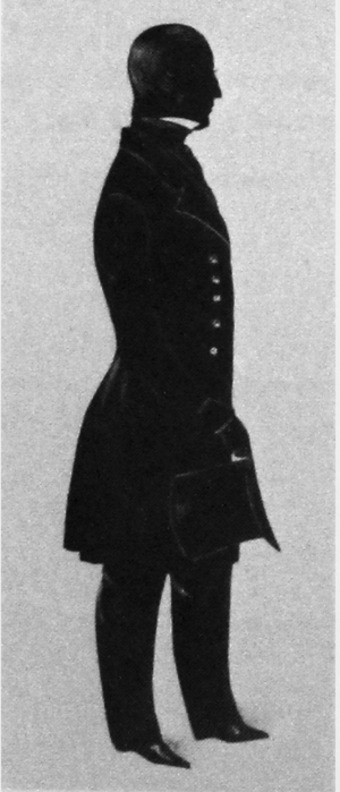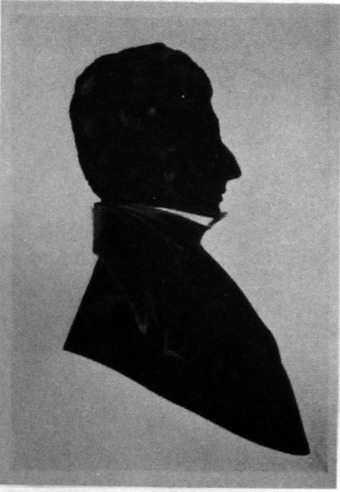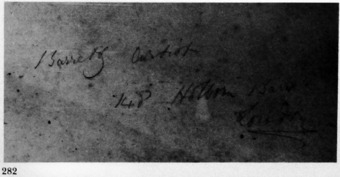Barrett (McKechnie Section 1)
See also Sections Six and Seven
Recorded by Jackson (Dictionary), who listed separately an artist named Barrets, who has since been proved to have been the same man. Although Barrett painted a mediocre profile miniature in colour (see Section Six), he is not listed by Foskett.
Jackson gave Barrett's address as 122 Holborn Hill, and gave two addresses for Barrets: 122 and 148 Holborn Bars. Examination of contemporary rate books and street directories gives us the information that Holborn, Holborn Hill, and Holborn Bars were originally consecutive sections of the same thoroughfare, though all the house numbers were in one continuous sequence. Nos 122 Holborn Hill and 122 Holborn Bars were therefore the same house. In the early 1840s, during which time Barrett appears to have been working, both the 'Hill' and the 'Bars' were included with Holborn itself, and the house numbers remained unchanged.
No. 122 was in fact the Bull Tavern, which would have been a good centre at which Barrett could set up a studio. Street directories for 1837-9 state, in fact, that a grocer named William Barrett had a shop at No. 147. No. 148 was a barber's shop, owned by a man named Gillingswater. Whether or not William Barrett, the grocer, was himself the profilist is uncertain, but it seems more than likely that it was a member of his family who used either the Bull Tavern or the barber's shop as a centre for the cutting of silhouettes.
To judge from his extant silhouettes, Barrett was working during the late 1830s and the early 1840s.
One pencilled signature of Barrett does look a little like `Barrets': no doubt it was this that led to Jackson's error.
I have seen little work by this artist. I own a full- length example, and Jackson illustrates in her Dictionary a bust-length example. Both sitters are men.
Much of the detail on the full-length profile is in lead pencil.
280
The gilding is sparse and coarsely applied. The figure stands against two vague wash scribbles beyond the feet; they give the portrait some substance. Hair and whiskers are crudely painted in gold; there is no attempt, for instance, to show the shape of the hair (in the 'lank' hair-style which was first in fashion towards the end of the 1830s) outside the edge of the cut paper. This cut edge is not concealed or built around.
The illustrated bust-length profile, taken perhapsa year or two earlier, seems scarcely better painted.
281
As it is known only from Jackson's illustration, it is impossible to say whether lead pencil was used. Coarse bronzing is visible. The bust-line is of the long sloping variety which is often seen on the work of John Dempsey. This example was obviously stuck to a rectangular card, and was probably also framed in rosewood.
I have not seen a complete printed trade label of Barrett. Jackson refers to one, but she does not give the address which it bears. Since it was probably on the example illustrated in her Dictionary, which is inscribed as having been taken at 148 Holborn Bars, this was probably used slightly later than some of the other inscriptions noted. Four labels or inscriptions are known. Trade label No. 1 is a stamped label, stencilled 'Barrett, 122, Holborn Bars'. It has been seen on a wooden backing (not on paper). Trade label No. 2 (printed) bears an address at 122 Holborn Hill; it is of a size to back a papier mache frame. The wording is as follows:
BARRETT
Artist
122, Holborn Hill
LONDON
Daguerreotype portraits
Miniatures on Ivory, Lifesize.
Portraits in Oil
Profiles, &c. taken in a superior manner, &
at astonishingly Low Charges.
Likenesses copied, repairs, &c.
Frames provided.
Trade label No. 3 is the label described by Jackson, who states that it measures 2 x 1 1/4, in. It may have borne an address, possibly 148 Holborn Bars, but, as Jackson mentions a signature and also states that the word 'Artist' appears on the label, the whole description is a little obscure. The illustrated example in the Dictionary shows no sign of a signature.
282
Trade label No. 4 is a pencilled inscription, on a full-length silhouette in my collection, which reads: 'Barrett, Artist. 148, Holborn Bars. London.'
Ills. 280-282

Unknown man
Cut silhouette, with detail in gold and pencil
c. 1840
10 x 8¼in./254 x 210mm.
Frame: rosewood, with gilt surround
Inscribed in pencil on the reverse ‘Barrett, Artist, 148, Holborn Bars, London’.
Author’s collection

Unknown man
Cut silhouette, embellished in gold on black paper
c. 1838-40
3½ x 2¾in./90 x 70mm.
From E. Nevill Jackson, ‘Silhouette: Notes and Dictionary’ (1938), by courtesy of Methuen and Co. Ltd

Pencilled inscription, ‘Barrett, Artist, 148, Holborn Bars, London’, on the silhouette illustrated in 280.
Author’s collection
